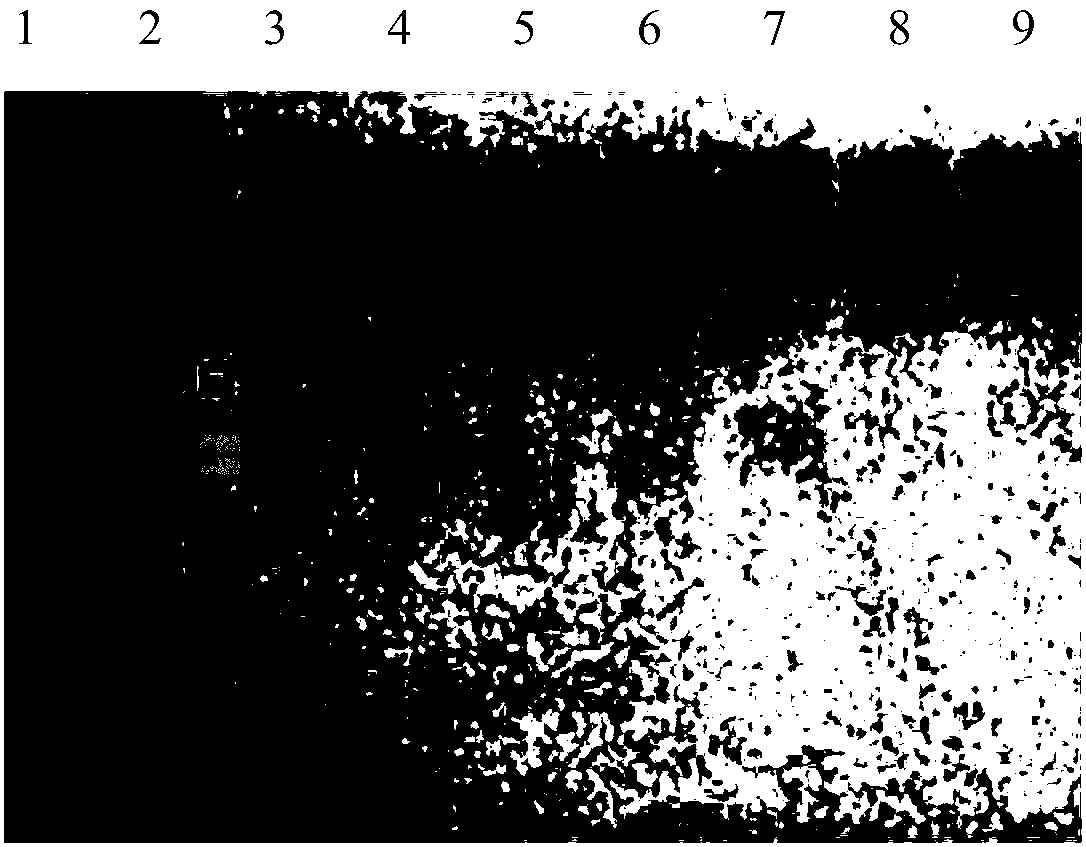PEG binding number detection method of PEG modifier protein
A detection method and technology of binding number, which is applied in the field of detection of PEG binding number of PEG-modified proteins, can solve problems such as difficulty in binding free amino groups, inaccurate analysis and detection of PEG binding number, etc., achieving good repeatability, accurate analysis, and simple operation Effect
- Summary
- Abstract
- Description
- Claims
- Application Information
AI Technical Summary
Problems solved by technology
Method used
Image
Examples
Embodiment 1
[0106] Example 1 PEG release+SDS-PAGE electrophoresis method to detect the number of PEG binding of asparaginase modified by PEG
[0107] 1. Operation process
[0108] The following uses enzymatic hydrolysis for sample treatment, SDS-PAGE electrophoresis followed by iodine staining, and Quantity One software quantification as examples to illustrate the complete operation process of PEG release + SDS-PAGE electrophoresis to detect PEG-binding number of PEG-modified proteins:
[0109] Preparation of trypsin solution: Accurately weigh 2.5g of trypsin powder, add 100mL PBS to dissolve, mix well to avoid foaming and damage to protein, filter and sterilize, then use, and place at 4°C.
[0110] Preparation of sample solution: Take 500 μl of the test solution with known protein content, place it at high temperature for 15 minutes, add 40 μL of trypsin solution, enzymolyze it in a water bath at 37°C for 20 hours, and set aside.
[0111] Prepare Tris-HCl buffer solution with pH 8.8: Di...
Embodiment 2
[0153]Example 2 PEG release+SDS-PAGE electrophoresis method detects the average number of PEG bindings of PEG randomly modified asparaginase
[0154] The detection methods all refer to Example 1 "1. Operation process", but the enzymatic hydrolysis time should be extended appropriately, at least 48 hours in a water bath to ensure that the PEG in the sample must be completely released. The PEG binding number detection results are shown in image 3 , Table 11, Table 12:
[0155] (Remarks: PEG mole number = PEG mass / PEG molecular weight (5KD); protein mole number = protein concentration × sample volume (0.1mL) / protein molecule (136KD); bring the above data into the calculation to get the coefficient 272)
[0156] Table 11
[0157]
[0158] Table 12
[0159]
[0160] The theoretical value of the PEG binding number of PEG randomly modified asparaginase is between 17-25. The above results prove that the PEG binding number of PEG randomly modified asparaginase can be detecte...
Embodiment 3
[0161] Example 3 PEG release+SDS-PAGE electrophoresis method detects the PEG binding number of PEG-ADI
[0162] Configuration of standard solution: Preparation of Novel-2-arm-40K PEG solution: Accurately weigh 10mg of Novel-2-arm-40K powder, add water to dissolve to 4mL, and make Novel-2-arm-40KPEG 2.5 per lmL mg solution, which is the polyethylene glycol stock solution, mix well and place.
[0163] Preparation of standard gradient solution: Add 2 μL, 4 μL, 6 μL, 8 μL, 10 μL, 15 μL of Novel-2-arm-40KPEG standard solution (2.5 mg / mL) into purified water to prepare a gradient solution with a final volume of 100 μL, and mix well , that is, the standard gradient solution.
[0164] Sample preparation and loading: Take 100 μL of the above-mentioned standard gradient solution and the test solution respectively, add 25 μL of 5× non-reducing loading buffer, mix well, and centrifuge, and the loading volume is 8 μL. The sampling time should be as short as possible to avoid sample diffu...
PUM
 Login to View More
Login to View More Abstract
Description
Claims
Application Information
 Login to View More
Login to View More - R&D
- Intellectual Property
- Life Sciences
- Materials
- Tech Scout
- Unparalleled Data Quality
- Higher Quality Content
- 60% Fewer Hallucinations
Browse by: Latest US Patents, China's latest patents, Technical Efficacy Thesaurus, Application Domain, Technology Topic, Popular Technical Reports.
© 2025 PatSnap. All rights reserved.Legal|Privacy policy|Modern Slavery Act Transparency Statement|Sitemap|About US| Contact US: help@patsnap.com



